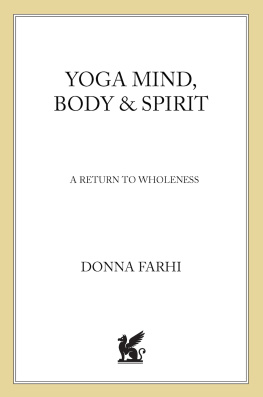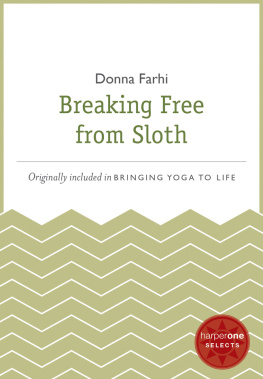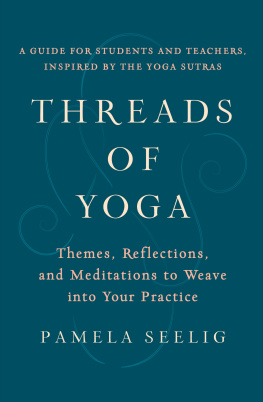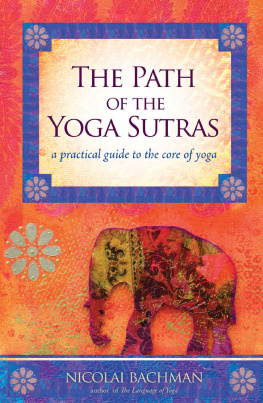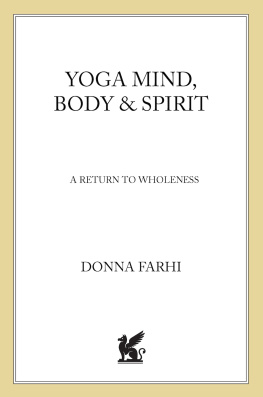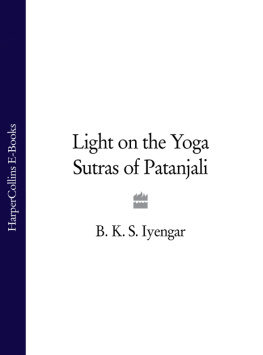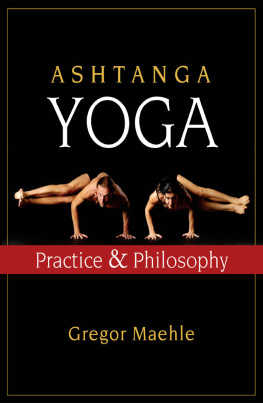Monday night is the evening for beginners at the studio, and although it is only five-thirty the winter sky has begun to darken as students arrive, some tentatively, others in boisterous pairs who have egged each other on to come, and the silent furtive ones, not yet sure whether there is a special way to act when entering a Yoga school. Robin arrives a little late and searches nervously for the farthest corner, to hide behind the other attendees. Why have you come? I ask, and as we introduce ourselves Robin declares, with an edge of cynicism that I have grown to recognize as the thickening of skin over something far more tender, that she wants to lose a little weight, maybe learn to relax. Seemed like a better option than ballroom dancing, she says smugly, raising a few eyebrows.
As the weeks go by, Robin begins to move forward in the room and to ask questions about the stiffness she feels in her back. I dont know, she says offhandedly, maybe it has something to do with my job. Some days I can hardly catch my breath. At the end of the first course Robin signs up for another, and months turn into years. A life is unveiled: an ambitious career, a marriage that didnt work out, a childhood much analyzed in therapy, and then an open question. How can this life become fresh again? How to peel away the veneer of self-defense and the sadness of disappointment? One summer Robin takes the leap and decides after much encouragement to attend a seven-day retreat. After a long and silent meditation one evening Robin comes to say good night, and we look into each others eyes. Something ineffable is exchanged: a recognition that something important has been realized. For once Robin drops her guard, and without saying a word I sense a warmth and tenderness that belie her practiced bravado. This is not where Robin began, yet it is a place that has always been there awaiting her arrival.
Over two decades of teaching I have witnessed again and again the power that Yoga has to shift seemingly intransigent negative patterns and to awaken the body, mind, and heart to other possibilities. No matter who we are or how long we have been entrenched in self-defeating behaviors, through daily Yoga practice we can become present to our own fundamental goodness and the goodness of others. Rediscovering who we really are at our core opens the way to experiencing our most basic level of connection with others. This connectedness lies at the heart of the practice called Yoga. Living in a unitive state is not an esoteric concept, and it is not an elusive higher realm that only very clever people can aspire to. It is the opening of the heart so that we have the capacity to feel tenderness, joy, and sorrow without shutting down. It is the opening of the mind to an awareness that encompasses rather than excludes. It is the startling and immediate recognition of our basic sameness. It is the practice of observing clearly, listening acutely, and skillfully responding to the moment with all the compassion we can muster. And it is a homecoming with and in the body for it is only here that we can do all these things.
Counter to the plethora of seven-step solutions and quick-fix formulas offered by so many contemporary self-help guides, the ancient science of Yoga does not pretend to be simple, quick, or easy. It is a practice that takes into account the very messy and often complex phenomenon of what we call a human being and the equally challenging task of everyday living. What Yoga does promise, however, is that through sincere, skillful, and consistent practice, anyone can become peaceful, happy, and free. It does not matter who you are or who you take yourself to be. Neither does it matter what has happened to you in the past or where you find yourself in the present. Anyone who has the intention to break through self-limiting and self-immobilizing thoughts and behaviors can and will find freedom through this practice. Regardless if you are a beginner or an experienced practitioner, the moment you engage in Yoga practice you will discover that the practice is itself the reward. Peace of mind and freedom from fear are as imminent as your focus. This change of mind has immediate consequences. You start to feel a sense of ease with life, and you feel more able to adapt to change. You experience a new vitality and clarity that affect your relationships at home, at work, and in the world.
That we may have come to see ourselves as separate and shut off from others is the central dilemma that we methodically dismantle in our Yoga practice because it is from this false sense of separation that we create so much of our own suffering and contribute to the suffering around us. We begin by putting aside a little time each day so that we can deliberately slow down and in doing so find a more natural rhythm that supports our well-being. This more relaxed rhythm allows us to reflect rather than react, to soften rather than harden, and to see clearly how things are now rather than dwell on the past or worry about the future. We achieve this in Yoga practice by simple means. Through the practice of postures we release pent-up tensions that have accumulated in our body, and we further refine our physical senses so that we become sensitive, adaptive, and resilient. Simultaneously, we reacquaint ourselves with the cyclic nature of our breath and its relationship to the sensate wisdom of our body. We learn to inhale completely and open to new experience. We learn to exhale completely and let go of unnecessary tension and the past. And we learn to rest in the pauses in between this arising and dissolving cycle. Like a surfer out on the ocean swell, we start to align ourselves with the ebb and flow of life rather than fight with it. Gradually we begin to recognize that in between the ups and downs and the coming and going, there is a matrix of stillness that is the backdrop of all phenomena.
Through these embodied practices we also methodically and meticulously retrain the mind to work for us rather than against us. We learn to focus the mind on one thing at a time, and in doing so we can attend to our everyday tasks and responsibilities fully and effectively. Eventually, as we begin to wake up to what is actually happening in the here and now, we start to notice that there is something unchanging and reliable in between, beneath, and throughout our everyday experience, and when we can stay anchored in this awareness we dont get caught up and wrung out by things that previously bothered us. It is this silent yet vibrant backdrop running through all things that provides us with a tangible thread of connection between seemingly disparate elements. Finding this thread and dwelling in the connection are the hallmarks of the yogic experience.
Inside this more natural rhythm where there is time to pause, breathe, feel, and perceive clearly, we find that the most valuable thing we can ever possess is clearly within our sights: this life itself. We may notice that while life has been living itself through us, we have been absent from the experience. Where did we go, and how can we come home to the larger life that is possible for us?
However we may have squandered our inheritance as a human being, we will find the practices forgiving and compassionate. Our first forays into practice may reward us with an immediate experience of peace, serenity, and homecoming. We may feel awe at all the exhilarating new sensations and insights that accompany our practice. As in every reunion, however, there is also the recognition of what may have been forgotten, what has happened during the time of exile, and what now needs to be reclaimed. Like a child who has waited too long for an overdue parent, we may feel anger or grief that we have neglected ourselves for so long. I cant believe I let myself get like this, students say, shocked to discover at the relatively young age of twenty or thirty that their bodies feel like deck chairs left out over a long winter. It may seem as if the body is an undifferentiated block of solid substance and we the owners have a blurry recognition of it at that. We may find that the heart has become hardened and bitter and that our minds may be perpetually scattered.



